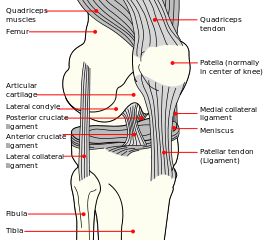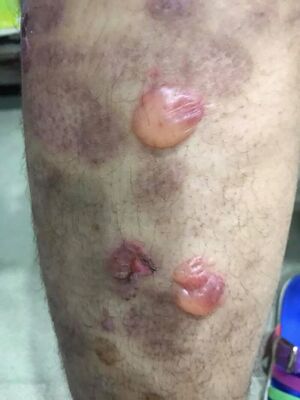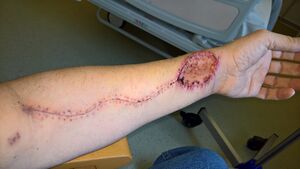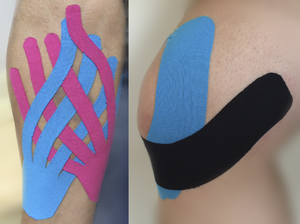Friction and its Application: Difference between revisions
No edit summary |
No edit summary |
||
| Line 28: | Line 28: | ||
If the knee joint<ref name=":1" />, the friction exists between the femoral component and the tibial condyles. The synovial fluid acts as lubricant. Muscles generates force to move the leg, which must be balanced with the frictional force that opposes the tendency of the movement at the knee. Leg remains stationary when the frictional force is equivalent to the horizontal pushing force exerted at the knee joint. But once the pushing force is greater than the frictional force as the body begins to move, the leg will change in position. | If the knee joint<ref name=":1" />, the friction exists between the femoral component and the tibial condyles. The synovial fluid acts as lubricant. Muscles generates force to move the leg, which must be balanced with the frictional force that opposes the tendency of the movement at the knee. Leg remains stationary when the frictional force is equivalent to the horizontal pushing force exerted at the knee joint. But once the pushing force is greater than the frictional force as the body begins to move, the leg will change in position. | ||
==== '''Coefficient of friction''' ==== | |||
The coefficient of friction is the ratio of ''frictional force'' to ''normal force'' that maintains surfaces together. | |||
* Coefficient of friction= Friction/Normal Force, represented by the Greek letter= μ. | |||
* '''(μ = f/N),''' For a body that is static, the normal force is the weight of the block. | |||
Every material has its own coefficients of static and kinetic frictions. Coefficients of friction are always positive and most tend to range from 0 to 1.<ref>Friction - Friction Coefficients and Calculator. Accessed from https://www.engineeringtoolbox.com/friction-coefficients-d_778.html on 23/4/24</ref> Research suggests friction coefficients in synovial joints ranges from 0.014 to 0.024 in cadaveric human ankle joint, with 0.02 in cadaveric hip joint<ref name=":3">Jin Z, Dowson D. [https://www.researchgate.net/publication/257811037_Bio-friction Bio-friction]. Friction. 2013 Jun;1:100-13.</ref>. It is influenced by change in temperature, the magnitude of the normal force, and speed. Lower coefficients of friction suggest that things slide off the material easily and higher coefficients of friction indicate that things don't glide easily. | |||
==== Factors affecting Fricition ==== | |||
Friction in the human joints is influenced by<ref name=":1" />: | Friction in the human joints is influenced by<ref name=":1" />: | ||
* Synovial fluid: the synovial membrane produces synovial fluid, which is a hydrodynamic fluid that acts as grease or oil in bodily joints where tissues move over one another, such as the wrist, fingers, ankles, toes, and knees. | * Synovial fluid: the synovial membrane produces synovial fluid, which is a hydrodynamic fluid that acts as grease or oil in bodily joints where tissues move over one another, such as the wrist, fingers, ankles, toes, and knees. | ||
* Bony Surfaces: The carpals and tarsals act as rollers or ball bearings similar to an axle in a wheel, in the knee joint. | * Bony Surfaces: The carpals and tarsals act as rollers or ball bearings similar to an axle in a wheel, in the knee joint. | ||
* Articular Cartilage: promotes the formation of fluid films and this reduces friction markedly. | |||
* Meniscus: removal of the meniscus in the medial compartment of the knee leads to the elevation of the friction force.<ref name=":2">McCann L, Ingham E, Jin Z, Fisher J[https://www.oarsijournal.com/article/S1063-4584(09)00042-9/fulltext . Influence of the meniscus on friction and degradation of cartilage in the natural knee joint]. Osteoarthritis and Cartilage. 2009 Aug 1;17(8):995-1000.</ref> | * Meniscus: removal of the meniscus in the medial compartment of the knee leads to the elevation of the friction force.<ref name=":2">McCann L, Ingham E, Jin Z, Fisher J[https://www.oarsijournal.com/article/S1063-4584(09)00042-9/fulltext . Influence of the meniscus on friction and degradation of cartilage in the natural knee joint]. Osteoarthritis and Cartilage. 2009 Aug 1;17(8):995-1000.</ref> | ||
'''Lubrication'''<ref name=":3" /> | |||
* | * The synovial fluid and formation of fluid films (by articular cartilage) reduces friction markedly. | ||
* ''' | * Another friction-reduction mechanism is biphasic lubrication in articular cartilage, which consists of both fluid and solid phases. ''Fluid phase:'' Immediately after loading, the fluid inside cartilage becomes compressed immediately after loading, causing the fluid to bear the majority of the strain, thereby reducing friction. ''Solid Phase:'' As time passes, the weight is shifted to the solid phase, and friction rises. Under sustained stress, boundary lubrication acts as an efficient method for limiting friction in synovial joints. | ||
* Other lubrication mechanisms is a “surface amorphous layer”, also described as “gel layer”, “hydration layer”, or “brush layer”, in which the chondroitin- or keratan sulphates constituting the leaves of the proteoglycan subunit are hydrated. | |||
* Effect of HA on the joint lubrication<ref>Tanaka E, Iwabe T, Dalla-Bona DA, Kawai N, van Eijden T, Tanaka M, Kitagawa S, Takata T, Tanne K. The effect of experimental cartilage damage and impairment and restoration of synovial lubrication on friction in the temporomandibular joint. Journal of orofacial pain. 2005 Oct 1;19(4).</ref>: HA provides lubrication and thereby decreases wear and tear. Administering HA injections to affected joints is shown to enhance mobility and alleviate pain and inflammation. According to study evaluating the effect of applying different molecular weights of HA to abraded articular cartilage in porcine TMJ, joint friction increased by about 350% following experimental scouring of the cartilage surface and impairment of synovial lubrication and HA application to the eroded cartilage surfaces reduced the frictional coefficient by approximately 50%. | |||
'''Meniscus''' | |||
The meniscus is crucial for knee joint function and disease progression, including osteoarthritis<ref name=":3" />. Studies in bovine knee joints have showed that the removal of the meniscus considerably raised the friction coefficient between the cartilage surfaces from 0.02 to 0.05 due to the increased contact pressure. | The meniscus is crucial for knee joint function and disease progression, including osteoarthritis<ref name=":3" />. Studies in bovine knee joints have showed that the removal of the meniscus considerably raised the friction coefficient between the cartilage surfaces from 0.02 to 0.05 due to the increased contact pressure. | ||
== Applications of Friction in Rehabilitation == | == Applications of Friction in Rehabilitation == | ||
Revision as of 21:02, 23 April 2024
Introduction[edit | edit source]
Friction plays a significant role in physiotherapy, especially in manual therapy techniques and therapeutic exercises. Friction, which is normally taken as a hindrance in everyday life, holds an important role in physiotherapy. It serves as a fundamental concept guiding movement mechanics, exercise selection, and injury prevention strategies.
What is Friction?[edit | edit source]
Friction is the opposing force that occurs between surfaces in contact and parallel to each other. In our body, it manifests in various scenarios, such as the interaction between joint surfaces, the contact between skin and supportive equipment, or the interface between the body and external surfaces during movement.[1]
Laws Governing Friction[edit | edit source]
The laws governing friction are [1]:
- Type of the Surface: Friction depends on the nature of the surfaces in contact, whether rough or smooth.
- Opposition to Motion: Frictional force acts to oppose the motion, serving as a stabilizing force during movement.
- Relative Velocity: The frictional force varies with the relative velocity between surfaces.
- Surface Area: Friction is independent of the surface area of contact between the surfaces
- Reaction Force: The frictional force is proportional to the reaction force pressing the surfaces together.
Friction in the Human Body[edit | edit source]
friction is the force that opposes the direction of motion. It can be classified into two types of friction:
- static: static friction exists when objects are at rest
- kinetic: when objects move against each other, there is kinetic friction. Static friction tends to be greater than kinetic friction.
If the knee joint[1], the friction exists between the femoral component and the tibial condyles. The synovial fluid acts as lubricant. Muscles generates force to move the leg, which must be balanced with the frictional force that opposes the tendency of the movement at the knee. Leg remains stationary when the frictional force is equivalent to the horizontal pushing force exerted at the knee joint. But once the pushing force is greater than the frictional force as the body begins to move, the leg will change in position.
Coefficient of friction[edit | edit source]
The coefficient of friction is the ratio of frictional force to normal force that maintains surfaces together.
- Coefficient of friction= Friction/Normal Force, represented by the Greek letter= μ.
- (μ = f/N), For a body that is static, the normal force is the weight of the block.
Every material has its own coefficients of static and kinetic frictions. Coefficients of friction are always positive and most tend to range from 0 to 1.[2] Research suggests friction coefficients in synovial joints ranges from 0.014 to 0.024 in cadaveric human ankle joint, with 0.02 in cadaveric hip joint[3]. It is influenced by change in temperature, the magnitude of the normal force, and speed. Lower coefficients of friction suggest that things slide off the material easily and higher coefficients of friction indicate that things don't glide easily.
Factors affecting Fricition[edit | edit source]
Friction in the human joints is influenced by[1]:
- Synovial fluid: the synovial membrane produces synovial fluid, which is a hydrodynamic fluid that acts as grease or oil in bodily joints where tissues move over one another, such as the wrist, fingers, ankles, toes, and knees.
- Bony Surfaces: The carpals and tarsals act as rollers or ball bearings similar to an axle in a wheel, in the knee joint.
- Articular Cartilage: promotes the formation of fluid films and this reduces friction markedly.
- Meniscus: removal of the meniscus in the medial compartment of the knee leads to the elevation of the friction force.[4]
Lubrication[3]
- The synovial fluid and formation of fluid films (by articular cartilage) reduces friction markedly.
- Another friction-reduction mechanism is biphasic lubrication in articular cartilage, which consists of both fluid and solid phases. Fluid phase: Immediately after loading, the fluid inside cartilage becomes compressed immediately after loading, causing the fluid to bear the majority of the strain, thereby reducing friction. Solid Phase: As time passes, the weight is shifted to the solid phase, and friction rises. Under sustained stress, boundary lubrication acts as an efficient method for limiting friction in synovial joints.
- Other lubrication mechanisms is a “surface amorphous layer”, also described as “gel layer”, “hydration layer”, or “brush layer”, in which the chondroitin- or keratan sulphates constituting the leaves of the proteoglycan subunit are hydrated.
- Effect of HA on the joint lubrication[5]: HA provides lubrication and thereby decreases wear and tear. Administering HA injections to affected joints is shown to enhance mobility and alleviate pain and inflammation. According to study evaluating the effect of applying different molecular weights of HA to abraded articular cartilage in porcine TMJ, joint friction increased by about 350% following experimental scouring of the cartilage surface and impairment of synovial lubrication and HA application to the eroded cartilage surfaces reduced the frictional coefficient by approximately 50%.
Meniscus
The meniscus is crucial for knee joint function and disease progression, including osteoarthritis[3]. Studies in bovine knee joints have showed that the removal of the meniscus considerably raised the friction coefficient between the cartilage surfaces from 0.02 to 0.05 due to the increased contact pressure.
Applications of Friction in Rehabilitation[edit | edit source]
Frictional effects play a crucial role in various aspects of physiotherapy practice:[1]
1. Supportive Equipment: The selection of supportive equipment, such as crutches or walking aids with rubber tips, relies on the high coefficient of friction provided by rubber against ground surfaces.
'2. Skin Protection: Friction management is essential to prevent skin injuries, such as blistering, which may occur in areas of high friction during movement or prolonged pressure.
3. Joint Functionality: Understanding the role of synovial fluid and joint mechanics helps in maintaining joint health and function, as synovial fluid serves as a lubricant to reduce friction between joint surfaces.
4. Exercise Design:Physiotherapists consider friction when designing exercises to enhance movement efficiency, reduce joint stress, and improve functional outcomes.
Effects of Friction in Physiotherapy[edit | edit source]
While friction is essential for movement and stability, its excessive or inefficient application can lead to adverse effects[1]:
1. Tissue Damage: Prolonged or excessive friction can cause the wearing and tearing of tissues, leading to pain, inflammation, and reduced mobility.
2. Energy Consumption: Friction contributes to the use of energy during movement, leading to increased fatigue and potential overheating of tissues.
3. Reduced Efficiency: Inefficient frictional interactions can impair movement efficiency, limiting the effectiveness of rehabilitation interventions.
Types of Friction Techniques Used in Physiotherapy[edit | edit source]
1.Soft Tissue Mobilization: We physiotherapists often use friction massage techniques to mobilize soft structures such as
- muscles,
- tendons,
- ligaments,
- fascia.
Friction massage involves applying pressure and rubbing movements directly to the affected area, aiming to break down adhesions, scar tissue, and muscle knots to improve tissue flexibility, reduce pain, and enhance circulation to promote healing.[6]
2. Cross-Fiber Friction Massage: in this technique friction is applied perpendicular to the direction of muscle fibers. It is commonly used to target specific areas of tissue dysfunction or to break down adhesions between muscle layers. Cross-fiber friction massage can help improve tissue mobility, reduce muscle stiffness, and alleviate pain.[7]
3. Scar Tissue Management: After surgery or injury, scar tissue may form, limiting the range of motion and causing pain and dysfunction. we use friction techniques, such as scar massage, to break down scar tissue adhesions and promote tissue remodeling. By applying controlled friction to the scar tissue, we can help improve tissue mobility, reduce scar adhesions, and enhance overall function.[8]
4. Trigger Point Release: Friction can be applied to trigger points—hyperirritable spots within taut bands of skeletal muscle—to release muscle tension and alleviate pain. we may use their fingers, thumbs, or specialized tools to apply localized friction to trigger points, helping to deactivate them and restore muscle function.
5. Joint Mobilization: we use friction during joint mobilization techniques to improve joint mobility and reduce stiffness. we may apply controlled friction to the joint surfaces to break down adhesions, increase synovial fluid circulation, and promote joint lubrication. This can help restore normal joint mechanics and reduce pain and dysfunction.[9]
6. Taping Techniques: such as kinesiology tape. we may apply friction to the adhesive side of the tape to activate its heat-sensitive properties, enhancing its adhesion to the skin and improving its therapeutic effects, such as providing support, reducing swelling, and enhancing proprioception.[10]
Physiological effects of friction massage[edit | edit source]
- Increased vasodilation[11][12]-Vasodilation refers to the expansion of blood vessels. Friction applied to the skin raises the temperature in localized areas, prompting blood vessels to unwind and expand. This expanded vasodilation facilitates greater delivery of oxygen and nutrient-rich blood to the muscles.
- Improved recovery[13]
- Breakdown / realignment of collagen fibres[8] and scar tissue -Frictions play a role in breaking down and realigning collagen fibers, which are a type of connective tissue characterized by their tough texture and high strength. Scar tissue, predominantly composed of collagen fibers, can develop following injury. However, it may disrupt the normal alignment of muscle fibers, leading to restrictions in movement and subsequent pain. Frictions, a specialized massage technique, target these restrictive tissues, aiming to realign the fibers to their natural orientation.
- Increased range of movement[14] and elasticity-Frictions additionally enhance tissue elasticity. When performed along the direction of muscle fibers, frictions can stretch and lengthen the tissues. Moreover, frictions elevate the temperature, promoting greater mobility of the tissue fibers, and facilitating their manipulation and stretching. Augmenting elasticity is crucial for improving mobility and preventing tightness
Conclusion[edit | edit source]
Friction is essential for regular functioning and has the potential to aid in the creation of diagnostic and interventional medical devices. It also has potential in disease development in certain organs of the body. Increased friction along with increased contact stresses leads to degradation and wear of cartilage. [3] [4] Also, understanding the laws governing friction is essential for rehabilitation professionals to analyze movement patterns and design effective rehabilitation programs.
Reference[edit | edit source]
- ↑ 1.0 1.1 1.2 1.3 1.4 1.5 Federal University of Technology, Owerri, & Tropical Publishers Nigeria. (2016). Human biomechanics: Basic and applied. Federal University of Technology, Owerri and Tropical Publishers Nigeria.https://www.researchgate.net/publication/357152541_Human_Biomechanics_Basic_and_Applied
- ↑ Friction - Friction Coefficients and Calculator. Accessed from https://www.engineeringtoolbox.com/friction-coefficients-d_778.html on 23/4/24
- ↑ 3.0 3.1 3.2 3.3 Jin Z, Dowson D. Bio-friction. Friction. 2013 Jun;1:100-13.
- ↑ 4.0 4.1 McCann L, Ingham E, Jin Z, Fisher J. Influence of the meniscus on friction and degradation of cartilage in the natural knee joint. Osteoarthritis and Cartilage. 2009 Aug 1;17(8):995-1000.
- ↑ Tanaka E, Iwabe T, Dalla-Bona DA, Kawai N, van Eijden T, Tanaka M, Kitagawa S, Takata T, Tanne K. The effect of experimental cartilage damage and impairment and restoration of synovial lubrication on friction in the temporomandibular joint. Journal of orofacial pain. 2005 Oct 1;19(4).
- ↑ Chaves P, Simões D, Paço M, Pinho F, Duarte JA, Ribeiro F. Cyriax's deep friction massage application parameters: Evidence from a cross-sectional study with physiotherapists.Musculoskeletal Science and Practice. 2017 Dec 1;32:92-7.
- ↑ Rasool F, Memon AR, Kiyani MM, Sajjad AG. The effect of deep cross friction massage on spasticity of children with cerebral palsy: A double-blind randomised controlled trial. J Pak Med Assoc. 2017;67:87.https://www.researchgate.net/profile/Aamir-Memon-3/publication/311775535_The_effect_of_deep_cross_friction_massage_on_spasticity_of_children_with_cerebral_palsy_A_double-blind_randomised_controlled_trial/links/585a6b6308aeabd9a58ca55e/The-effect-of-deep-cross-friction-massage-on-spasticity-of-children-with-cerebral-palsy-A-double-blind-randomised-controlled-trial.pdf
- ↑ 8.0 8.1 Barnes SP, Ma Y, Patel B, Muthayya P. Efficacy of massage techniques for hypertrophic burn scars – A systematic review of the literature. J Burn Care Res. 2024;45(2):356-365. doi:10.1093/jbcr/irad140 https://academic.oup.com/jbcr/article-abstract/45/2/356/7270579
- ↑ Nor Azlin MN, Su Lyn K. Effects of passive joint mobilization on patients with knee osteoarthritis. Sains Malaysiana. 2011;40(12):1461-1465.http://www.ukm.edu.my/jsm/pdf_files/SM-PDF-40-12-2011/17%20Nor%20Azlin.pdf
- ↑ Mohamadi M, Piroozi S, Rashidi I, Hosseinifard S. Friction massage versus kinesiotaping for short-term management of latent trigger points in the upper trapezius: a randomized controlled trial. Chiropr Man Therap. 2017;25:25.https://link.springer.com/article/10.1186/s12998-017-0156-9
- ↑ Cambron JA, Dexheimer J, Coe P. Changes in blood pressure after various forms of therapeutic massage: A preliminary study. J Altern Complement Med. 2006;12:65–70.
- ↑ Holey E, Cook E. Evidence-Based Therapeutic Massage. A Practical Guide for Therapists. 2nd ed.Edinburgh: Churchill Livingstone; 2003
- ↑ Leivadi S, Hernandez-Reif M, Field T, et al. Massage therapy and relaxation effects on university dance students. J Dance Med Sci. 1999;3:108–112
- ↑ Hopper D, Deacon S, Das S, et al. Dynamic soft tissue mobilization increases hamstring flexibility in healthy male subjects. Br J Sports Med. 2004;39:594–598












